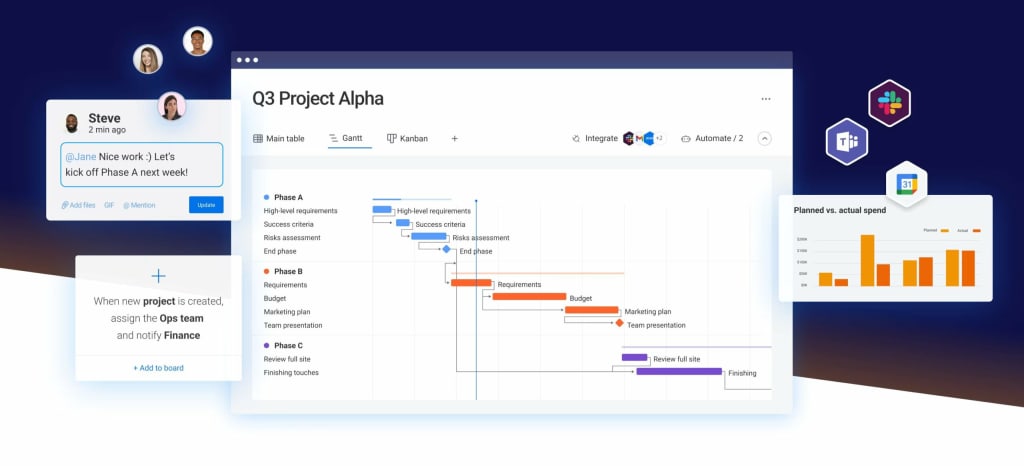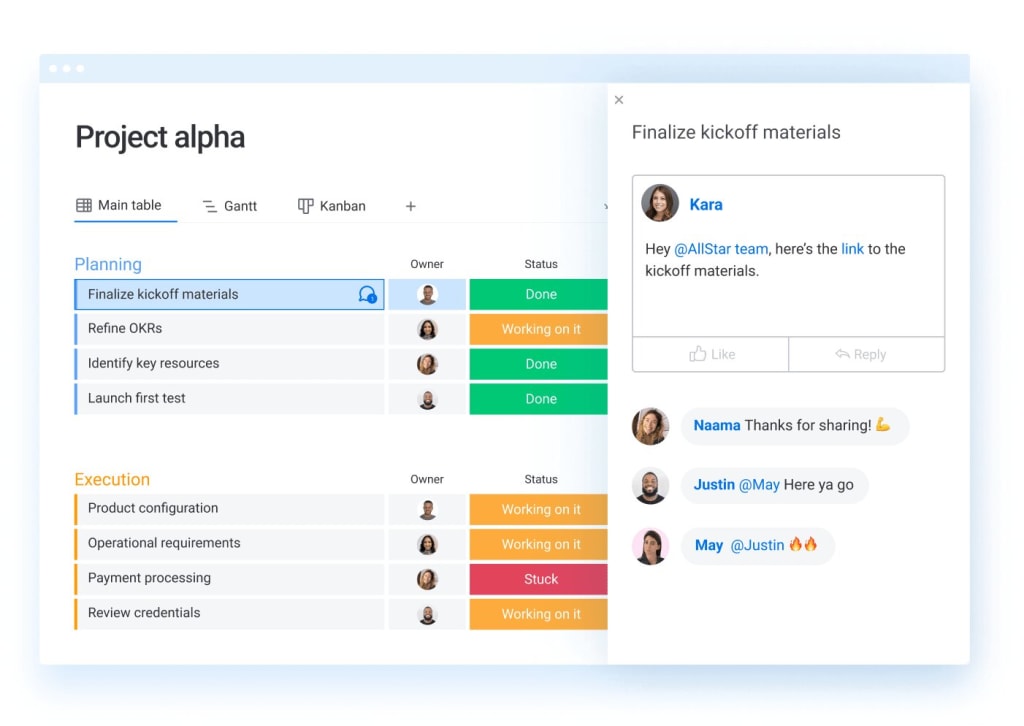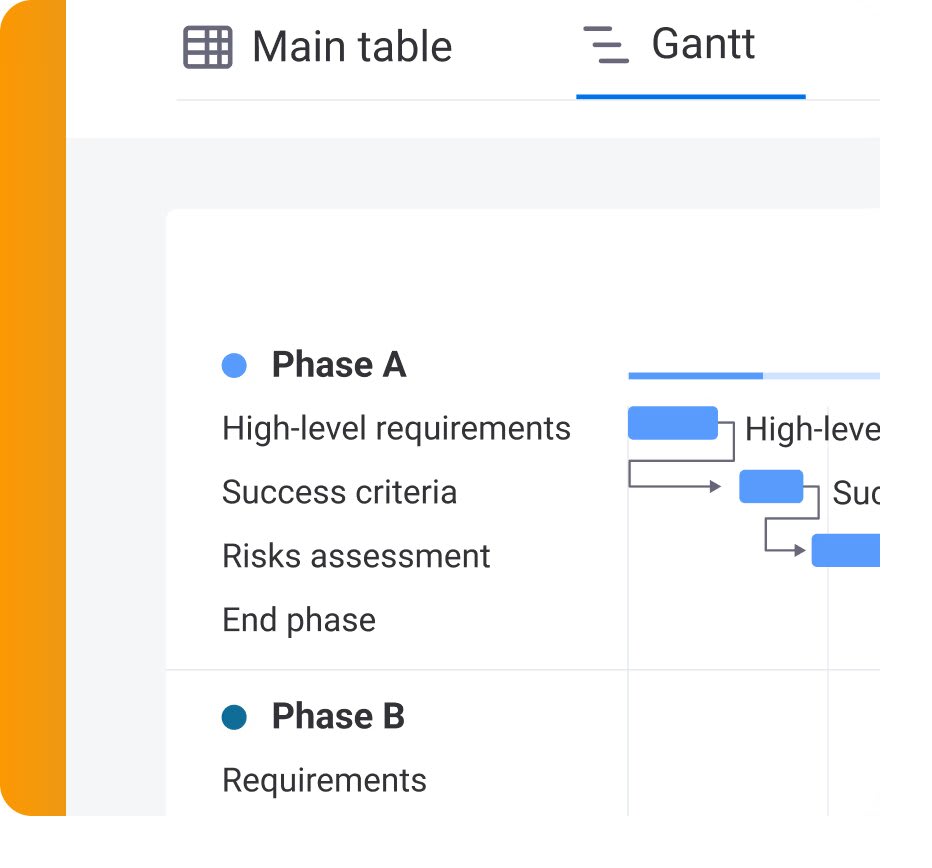When planning a project, your top concern is delivering successful results that satisfy your stakeholders. Back in the day, you could achieve this by producing a product on time, on or below budget, with a high level of quality. But the final result is no longer the single measure of the project’s success.
In this guide, we’ll discuss today’s expanded view of project success criteria, including how stakeholders want to understand whether new products and services meet customer expectations and boost organizational processes. We’ll also explore how to track all aspects of project success on the monday.com Work OS.
How do you define project success criteria?
Success criteria refer to the standards stakeholders use to determine if the project meets their expectations. Project managers may examine these during the project lifecycle and after the project close. The criteria are somewhat focused on budget and schedule but also consider how stakeholders – leadership, employees, and customers – are affected by the result of your project. Here are some questions you can ask to define project success:
Did the customer accept the project?
Does the product or service meet the customer’s brief? Does it perform as expected and align with the business case? Have tools and support been implemented to make change easy on customers, and does it improve their experience?
Does the project contribute to organizational workflows?
Have new efficiencies or workarounds been created that will have a positive impact on performance? Does the outcome improve or at least not change how things work today? Does it advance the technology used by the organization?
How does the project impact the organization’s culture?
Will new processes affect how team members interact with each other or their customers?
Overall, the main focus is on the customer having a good experience while the project is in flight or following the launch of a new product or service. Start by defining what success means for your team and stakeholders, in terms of real, measurable criteria you can track on the monday.com Work OS.
6 examples of project success criteria
There’s no one-size-fits-all approach to defining success criteria, and project managers will be guided by the specific needs of their stakeholders. We asked Matt Burns, Project Manager at monday.com, how he ensure his projects hit the mark. He told us he always asks the following question to provide a framework to shape his project management:
“If I have a magic wand, and this goes perfectly for you and does exactly what you want in your heart and soul, what does that look like for you?”
Some common examples of project success criteria you might track to build your own framework include:
- Scope: The project manager will begin by defining the project’s scope and establishing what needs to happen to consider it a success. On the monday.com Work OS, you can define a baseline to set project scope, then make necessary adjustments along the way.
- Budget: No project manager wants their project to be a money drain. Establish a budget and compare it to actual expenses throughout the project’s lifecycle.
- Timeline: The timeline of the project should be included when defining success criteria, including meeting milestones and deadlines to achieve success. This is easy to accomplish on monday.com, where you can mark significant checkpoints to measure and share project progress.
- Business Goals: Consider customer goals, organizational goals, and project management team goals. A successful project will ensure these are all in alignment.
- Deliverables: Check that the project deliverables align with expectations and are satisfactory. For example, if your project goal is to produce a new app, the deliverable should be a fully functional, bug-free app that is intuitive and meets the customer’s needs.
- Risk management: The project manager should be able to identify risks early on and develop mitigation strategies. For example, on the monday.com Work OS, you can use real-time data to track, monitor, and mitigate any roadblocks throughout the project lifecycle.
You can create and manage these project success criteria and more thanks to the curated yet flexible features on monday.com.
Get startedHow do you write success criteria for a project?
Begin by deciding on the categories of your success criteria, for example, project management or project delivery success criteria, then make a list of priorities.
For project management, your success criteria might be to:
- Hold weekly project team update meetings
- Conduct one-on-one tracking meetings with the team lead
- Conduct a monthly detailed budget review
- Ensure all milestones attain stakeholder sign-off
For project delivery, your success criteria might be to:
- Approve Change Management & Communications Plans by the end of the month
- Deliver training to the entire Customer Service Organization by the end of the quarter
- Improve call completion time by 20% over first-month post rollout
- Improve customer satisfaction survey results by 10 points within three months
What are the benefits of measuring project success?
Measuring project success enables you to gain greater visibility into the progress and results of your projects to :
Establish goals and objectives
Tracking and measuring results begins with benchmarking goals from the get-go. By doing so project managers can benefit by ensuring everyone involved is on the same page and working towards the same result. Everyone, from senior stakeholders to team members, will understand the project’s purpose and how their role contributes to its success.
Meet milestones
By tracking progress, you’ll identify any potential issues before they arise. This ensures that the team is able to meet the expectations for the delivery of a successful project.
Evaluate project management methodologies
Project managers can assess the effectiveness of their project management techniques to assist in future planning. For example, if traditional project management methods like Waterfall fail, you can adjust the process to something more agile.
Make data-driven decisions
Access to measured data allows for more intelligent decision-making for this project and future projects. You’ll be able to make decisions about resource allocation and budgeting based on the actual results of your work.
Manage project risks
With data about the progress of your project, you can monitor risk factors and act swiftly if something goes wrong. This keeps potential issues from spiraling out of control, so your project can stay on track and achieve a successful outcome.
4 tips to achieve project success
Give your project every chance at success by following these tips that will make a big difference:
1. Establish a baseline
The baseline measure tells you how the areas of the business that your product will impact are performing today.You’ll make your comparison against this data, so be sure to use the same measurement tools for baselining and measuring. If your goal is to improve call answer times, you need to know how long it takes representatives to answer the phone now so you know what you’re trying to achieve.
2. Get stakeholder buy-in and sign-off
With well-defined targets and a baseline to perform against, you can engage your stakeholders, keep them updated, justify requests, and get their support when needed. Ask for sign-off to have a history of positive results that stakeholders can see.
3. Use continuous measurements
Improvements take time, so setting a very rigid set of criteria may not allow time for the new product or service to show any real impact. Set targets with a range – like improving performance by 25 to 35 percent over three months – to give yourself room to grow.
4. Use project management software
Tracking project success using paper and pen is time-consuming and can be inaccurate. A powerful project management tool is the way to go if you want a more efficient way to measure progress and success. The monday.com Work OS can automate the process and make tracking easier.
Get startedTrack progress and measure project success on monday.com
Connect all the moving parts of your project on the monday.com Work OS. We offer a wide variety of features to achieve project success, including:
Centralize project success planning
Use the appealing centralized dashboard to formally log your project success criteria name, such as “Improved Customer Satisfaction Scores,” and your measurement method. A best practice is to include the frequency of measurement, such as weekly or monthly budget reviews.

Collaborate with stakeholders
Eliminate knowledge silos with open communication channels from a central location. Update changes in real-time, and allocate resources to team members as required. For example, a PM should track contractor hours, while a Business Analyst can track software testing.

Monitor project success
Set milestones for your desired outcomes, such as reducing customer cancellations by 20% by X date. List what issues you’ve identified and how you plan to resolve them.

Track dependencies
Keep multi-stage projects on track by informing all key stakeholders when they need to commence work.

Integrate with key project management tools
Ensure your project runs smoothly by connecting essential third-party tools like Slack, Jira, or Salesforce to keep your data and teams perfectly aligned.

These are just a few of the features available on the monday.com Work OS to set and track your project success criteria. Explore all of these and more by signing up for a free trial below.
FAQs
What is success criteria in project management?
Success criteria in project management are the measures used to determine whether a project has been successful. The criteria will depend on your project and goals but often includes scope, budget, timeline, business goals, deliverables, and risk management. Project manager Matt Burns recommends outlining these before you begin the project.
“The number one thing is the initial definition you set with stakeholders, which you should do at the beginning. If you want to go somewhere and you don’t have a map, you’re probably going to get lost.”
How do you measure project success criteria?
Measure project success criteria by defining what metrics you are going to use and how frequently you will track them. View them from a centralized dashboard on the monday.com Work OS to keep all the stakeholders informed about progress and identify any areas of concern.
Who is in charge of setting project success criteria?
Typically, the project manager will establish goals for the project, along with success criteria to measure whether those goals have been achieved. Although the PM is responsible, they will liaise with stakeholders and customers to define these criteria. If necessary, create a formal agreement or contract between all parties involved. This ensures everyone is on the same page about what success looks like.
Establish new project success criteria
Once the project closes, your team will no longer be responsible for tracking the product’s performance, so be sure to build a solid measurement process into the handoff activities. New criteria should be established and logged on the monday.com Work OS to set goals for continuous improvement and measurable success.

